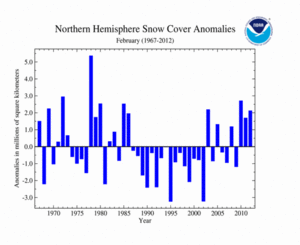NH Snow Cover Extent
Data were provided by the Global Snow Laboratory, Rutgers University. Period of record is 1966-2012 (46 years).
The Northern Hemisphere snow cover extent during February 2012 was above average and ranked as the 8th largest February snow cover extent in the 46-year period of record. The monthly snow cover extent was 2.1 million square km (810,800 square miles) above the long-term average of 45.7 million square km (17.6 million square miles). There was significant variability between the Eurasian land area and the North American land area snow cover during the month. For the winter period (December-February), the Northern Hemisphere experienced an above-average snow cover extent — the 14th largest (33rd smallest) on record.
During February 2012, the North American snow cover extent was below average, ranking as the 16th smallest (31st largest) monthly snow cover extent on record. This marks the first February since 2006 with below-average snow cover extent for the continent. The monthly average snow cover extent was 16.6 million square km (6.4 million square miles), 419,000 square km (161,800 square miles) below the long-term average. According to data from the Rutgers Global Snow Lab, the contiguous U.S., as a whole, experienced below-average snow cover during the month, particularly across the Northern Plains and the high elevations of the West. Canada and Alaska both experienced near-average snow cover extent during the month. For the winter season, North America experienced much-below-average snow cover extent — the fourth smallest seasonal snow cover extent on record. This is the first winter with below-average snow cover for the continent since 2006, and the smallest since 2000.
Eurasian snow cover extent during February 2012 was the third largest on record, 2.5 million square km (965,000 square miles) above the average of 28.6 million square km (11.0 square miles). This was the largest February snow cover extent since 1978. The February 2012 monthly snow cover extent was also the fifth largest snow cover extent of any month on record, behind January 1978, February 1972, January 2008, and February 1978. At the beginning of February, a cold air outbreak brought significant snowfall to much of central and eastern Europe, killing at least 650 people. More information can be found in the February Global Hazards report. According to data from the Rutgers Global Snow Lab, much of Europe, western Asia, and central China experienced above-average snow cover. Below-average snow cover was observed in eastern China. For the winter, the snow cover extent was also above average, ranking as the fourth largest seasonal snow cover extent on record and marking the largest winter snow cover extent since 2003.
Sea Ice Extent
According to the National Snow and Ice Data Center (NSIDC), the Northern Hemisphere sea ice extent — which is measured from passive microwave instruments onboard NOAA satellites — averaged for February 2012 was 14.56 million square kilometers (5.62 million square miles), 6.9 percent below the 1979-2000 long-term average, and the fifth smallest February ice extent on record. The five smallest February Arctic sea ice extents have occurred since 2005. February 2012 is the 14th consecutive February and the 129th consecutive month with below-average Arctic sea ice extent. February Arctic sea ice has decreased at an average rate of 3.0 percent per decade.
The amount of sea ice varied across the Arctic during February. In the Barents Sea, ice content was much below average, and the sea had its lowest ice total for February on record. Conversely, the Bering Sea experienced above-average ice. Most other regions of the Arctic experienced near to slightly below-average ice coverage for the month.
The February 2012 Southern Hemisphere sea ice extent was 3.54 million square km (1.4 million square miles), or 20.3 percent above the long-term average of 2.9 million square km (1.1 million square miles) — the fifth largest February extent on record. This is the largest February sea ice extent for the Southern Hemisphere since 2008. Throughout the month, which is part of the annual melt season for the Antarctic, sea ice trended above average. Southern Hemisphere February sea ice extent has increased at an average rate of 2.6 percent per decade with significant inter annual variability.
For further information on the Northern and Southern Hemisphere snow and ice conditions, please visit the NSIDC News page.
 NOAA's National Centers for Environmental Information
NOAA's National Centers for Environmental Information




